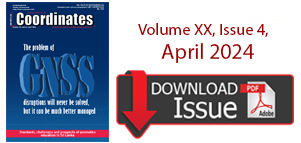Articles in the Articles Category

A metric, Vulnerability Index Against Spoofing, is proposed and used to assess the effectiveness of a spoofer. The GNSS (Global Navigation Satellite System) positioning is known to be vulnerable to interference due to the long distance of radio-signal travel and the resulting low signal power. In the presence of interferences or spoofing, the GNSS navigation performance is likely to be degraded and the navigation function may even be incapacitated. Throughout the years, many GNSS interference mitigation techniques have been developed.

A brief outline of the three segments – User Segment, Space Segment and Ground Segment necessary for
implementation of an SBAS system over the Indian airspace. International Civil Aviation Organisation (ICAO) Member States have endorsed Global Satellite Navigation System (GNSS) as a primary future system for aviation. GNSS provides world-wide coverage for seamless aircraft navigation. Satellite transmission along with ground enhancement will enable the users to perform on-board position determination for enroute, terminal, non-precision and precision approaches.

According to the report……, “Despite significant growth since 2006, significant untapped potential remains.” Would you like to elaborate on this?
According to the forecast based on available information sources and which involved several market experts, the global GNSS revenues are still expected to grow at a double digit CAGR in the 2010 – 2020 period. This growth will come from both new applications and expansion of current products and services. In terms of penetration, the biggest impact will come from LBS since GNSS is still only in a small portion of today’s mobile phones. Regarding new applications, there are countless examples such as ADAS (Advanced Driver Assistance Systems). As for GNSS R&D initiatives in the context of the EU 7FP program of the European Commission, being delegated to the GSA, there is a surge of GNSS technology projects proposing creative applications such as using combined radar and satellite navigation technologies to create maps of coastal areas. Advances in EGNOS and Galileo will accelerate these developments.
February 2011
ILMF 2011
7 – 9 February2011
New Orleans, LO, USA
www.lidarmap.org/ILMF.aspx
16 International Geodatic Week
13- 19 February 2011
Obergurgl, Austria
www.geodaesie.uibk.ac.at/obergurgl.html
March 2011
The Munich Satellite Navigation Summit 2011
1-3 March
Munich, Germany
www.munich-satellite-navigation-summit.org
GEOFORM-2011
15-18 March
Moscow, EcoCentre Sokolniki
www.geoexpo.ru/defaulteng.stm
April 2011
6th National GIS Symposium in Saudi Arabia
24-26 April
Khobar, Saudi Arabia
www.saudigis.org
Geo- Siberia 2011
27-29 April
Novosibirsk, Russia
www.geosiberia.sibfair.ru/eng/
May 2011
ASPRS 2011
1 – 5 May
Milwaukee, Wisconsin, USA
www.asprs.org/milwaukee2011/
Gi4DM 2011
3 – 8 May
Istanbul, Turkey
www.gi4dm.org
June 2011
Trans …

Giovanni Dore, Mario Calamia
The integrity concept, intended as a continuous control of the information broadcast by the satellites, has been introduced by the Galileo system. Though the RAIM technique represents the first example of integrity monitoring, it has the characteristic to detect only local errors, at receiver level. The integrity monitoring applied by EGNOS, instead, could be seen as the forerunner of the Galileo one. Though there are many differences in the definition of integrity of the two system, the main aim is the same for both, that is to protect the user…

Diplomacy, democracy, autocracy, hypocrisy.
Mess, Press, suppress.
Expose and impose.
Dare, share and scare.
Fear and smear.
Right and rights.
Preach and practice.
Action and overreaction.
Force and coerce.
Sneak and sleaze.
Damage and rampage.
Credibility and vulnerability.
Cover and cover up.
Control, control and control.
Bal Krishna, Editor
bal@mycoordinates.org
Tweet

says Matthew M O’Connell, CEO, President and Director, GeoEye
From 2006 to 2010, it has been quite a journey for GeoEye. What were the highlights of this incredible journey?
It’s hard to believe how far we’ve come. Just 7 ½ years ago, GeoEye had 60 employees generating $9 million per year, and our equity was worth …

Says, Dr Dru Smith, Chief Geodesist of NOAA’s National Geodetic Survey while explaining the GRAV-D project
What is the GRAV-D project?
GRAV-D stands for “Gravity for the Redefinition of the American Vertical Datum”. It is a multi-year project designed and led by the National Geodetic Survey (NGS). GRAV-D was initiated to measure and monitor …

Suresh V Kibe
The Ministry of Civil Aviation, Government of India has the sovereign authority to modernize the Indian Airspace. Rapid strides have been made by the Ministry of Civil Aviation in implementing many elements of the Global Air Navigation Plan recommended by the International Civil Aviation Organisation (ICAO) for Communications, Navigation, Surveillance (CNS)/Air Traffic Management (ATM) systems. India is a founding member of ICAO and is a regional member of the ICAO Asia Pacific Air Navigation Planning …

Jong-Hwa Song,GYU-IN JEE
This paper describes the performance improvement of GPS/DR (Global Positioning System/Dead Reckoning) Integration system utilizing the area decision algorithm and vehicle movement information. In GPS/DR Integration system, generally DR sensor errors are estimated and corrected using GPS information when GPS is available. In GPS signal blockage area, i.e., tunnel and underground parking area, DR sensor errors are accumulated and navigation solution is diverged eventually. We utilize the car movement…







 (5.00 out of 5)
(5.00 out of 5)